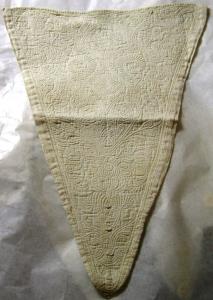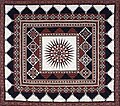Corded quilting

Centraal Museum Utrecht

Corded quilting (also known as Marseilles quilting, Marseilles embroidery, marcella, or Zaans stitchwork) is a decorative
running stitches or backstitches to form channels, and soft cotton cord is inserted through the backing fabric using a blunt needle and drawn along the quilted channels to produce a raised effect. Tiny quilting stitches in closely spaced rows fill the motifs and provide contrast to the corded outlines.[1][2][3]
Corded quilting was popular for
Federal era in America, corded quilting and trapunto were combined with whitework embroidery and other needlework techniques to produce a profusion of white-on-white textiles for the home before the fashion faded.[2][3]
The principal areas of production using this technique were southern France and Italy.[5]
Notes
References
- Bath, Virginia Churchill (1979). Needlework in America. Viking Press. ISBN 0-670-50575-7.
- Takeda, Sharon Sadako, and Kaye Durland Spilker, Fashioning Fashion: European Dress in Detail, 1700 - 1915, LACMA/Prestel USA (2010), ISBN 978-3-7913-5062-2
- Weissman, Judith Reiter and Wendy Lavitt: Labors of Love: America's Textiles and Needlework, 1650-1930, New York, Wings Books, 1987, ISBN 0-517-10136-X
External links
 Media related to Corded quilting at Wikimedia Commons
Media related to Corded quilting at Wikimedia Commons

